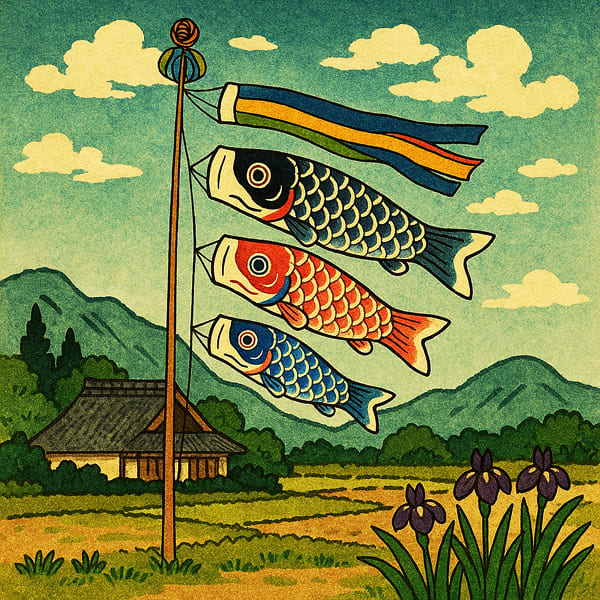Children's Day in Japan: Traditions, Symbols, and How It's Celebrated

Contents
Carp streamers flutter in the breeze, samurai helmets shine in the sunlight, and families gather to celebrate their children.
In Japan, May 5th is Children’s Day (Kodomo no Hi), a time to honor the health, growth, and happiness of the next generation.
But what makes this day so special? How do people in Japan celebrate it?
Let’s explore the traditions, history, and heartfelt meaning behind this colorful holiday.
What Is Children’s Day?
Children’s Day is a national holiday in Japan, celebrated every year on May 5th as part of the country’s Golden Week. It’s a day to honor the health, growth, and happiness of all children, regardless of gender.
The holiday was officially established in 1948 which states its purpose as:
"to respect the personality of children, promote their happiness, and express gratitude toward mothers."
Originally, May 5th was known as Tango no Sekku, a seasonal festival focused on boys. Over time, it transformed into a more inclusive celebration that recognizes all children and highlights the important role of family and caregivers in their upbringing.
To understand Children’s Day more deeply, it’s important to also learn about its traditional origin—Tango no Sekku.
The Roots: What Is Tango no Sekku?
Tango no Sekku (端午の節句) is one of Japan’s five traditional seasonal festivals (gosekku), and its customs have evolved over centuries. Let’s explore how this celebration developed through Japanese history.
Nara Period: A Ritual Against Evil
The origins of Tango no Sekku can be traced back to ancient Chinese purification rituals, introduced to Japan during the Nara period (8th century). People believed that herbs like iris (shōbu) and mugwort (yomogi) had the power to ward off disease and evil spirits.
During this time, Tango no Sekku was not specifically associated with boys. It was observed by decorating eaves with herbs and taking iris baths (shōbuyu) to stay healthy and safe.
Kamakura to Muromachi Periods: The Rise of Warrior Culture
As Japan entered the samurai era, the festival took on new meanings. The word shōbu (iris) sounded the same as shōbu (尚武), meaning “to value martial spirit.” This wordplay helped connect the festival with the ideals of bravery and honor.
Tango no Sekku gradually became a day to pray for the healthy growth and future of boys, especially as future warriors in the samurai class.
Edo Period: From Warriors to Family Traditions
By the Edo period, the festival had become more elaborate and closer to how it is celebrated today. Samurai families displayed miniature armor and helmets (kabuto) in their homes as symbols of protection and courage.
When a male heir was born to the shogun, battle standards and banners were raised outside the residence. This practice inspired the creation of koinobori—carp-shaped streamers that represent perseverance and success.
Over time, these traditions spread from the warrior class to the general population. Even today, the customs of Tango no Sekku—from decorations to seasonal foods—continue to shape the spirit of modern Children’s Day.
How Children’s Day Is Celebrated Today
Although rooted in ancient rituals and samurai traditions, many of the customs from Tango no Sekku are still lovingly practiced in modern Japan.
1. Kabuto and May Dolls: Tradition with a Modern Touch
Inside the home, many families display kabuto (samurai helmets) and Gogatsu Ningyo (May dolls). While these items originally symbolized protection and warrior spirit, today they are often seen as cultural heirlooms or artistic decorations that connect children to Japan’s rich heritage.
2. Koinobori: A Symbol of Strength for Every Child
The tradition of flying koinobori—carp-shaped streamers—continues across the country. Once flown to honor sons, today they represent all children, with each streamer symbolizing a family member: the black carp for the father, red or pink for the mother, and additional colorful carps for each child. The image of carps swimming upstream still expresses wishes for resilience, growth, and success in life.
3. Seasonal Foods and Family Time
Traditional sweets like kashiwa mochi and chimaki remain a beloved part of the celebration. Kashiwa mochi, wrapped in oak leaves that do not fall until new shoots appear, symbolizes the continuity of family lines. Chimaki, popular in western Japan, carries memories of old purification customs.
4. Shōbuyu: Iris Baths for Protection and Wellness
Another tradition still practiced today is shōbuyu—taking a bath with iris leaves on Children’s Day. This custom, which dates back to ancient times, is believed to ward off illness and bring good health and protection to the family. Even now, supermarkets across Japan offer bundles of iris leaves around May 5th.
Children’s Day is a time for families to come together—whether through outings, photo sessions, or simply sharing a meal. Many schools and communities also host events or art projects that allow children to express their dreams and creativity.
Final Reflections: The Heart of Children’s Day
While Children’s Day is filled with color, tradition, and celebration, at its core it is a day for families to pause and reflect.
It reminds us of the shared responsibility to protect and nurture the next generation—not only in body, but in spirit and heart.
From its ancient roots in Tango no Sekku, where rituals warded off misfortune and symbolized strength, to today’s joyful expressions of love and unity, May 5th has continued to evolve alongside Japanese society.
Whether you’re admiring fluttering koinobori, enjoying a sweet bite of kashiwa mochi, or simply spending time with loved ones, this special day invites us all to honor the promise of childhood—and to celebrate the quiet strength found in family, hope, and tradition.